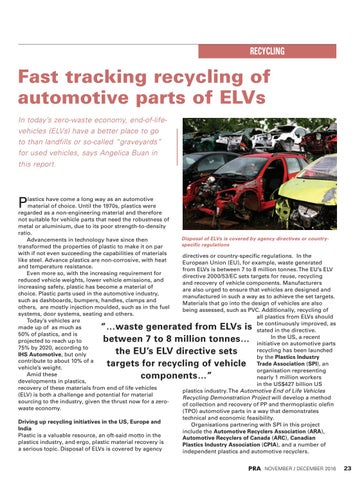Recycling
Fast tracking recycling of automotive parts of ELVs In today’s zero-waste economy, end-of-lifevehicles (ELVs) have a better place to go to than landfills or so-called “graveyards” for used vehicles, says Angelica Buan in this report.
P
lastics have come a long way as an automotive material of choice. Until the 1970s, plastics were regarded as a non-engineering material and therefore not suitable for vehicle parts that need the robustness of metal or aluminium, due to its poor strength-to-density ratio. Advancements in technology have since then transformed the properties of plastic to make it on par with if not even succeeding the capabilities of materials like steel. Advance plastics are non-corrosive, with heat and temperature resistance. Even more so, with the increasing requirement for reduced vehicle weights, lower vehicle emissions, and increasing safety, plastic has become a material of choice. Plastic parts used in the automotive industry, such as dashboards, bumpers, handles, clamps and others, are mostly injection moulded, such as in the fuel systems, door systems, seating and others. Today’s vehicles are made up of as much as 50% of plastics, and is projected to reach up to 75% by 2020, according to IHS Automotive, but only contribute to about 10% of a vehicle’s weight. Amid these developments in plastics, recovery of these materials from end of life vehicles (ELV) is both a challenge and potential for material sourcing to the industry, given the thrust now for a zerowaste economy.
Disposal of ELVs is covered by agency directives or countryspecific regulations
directives or country-specific regulations. In the European Union (EU), for example, waste generated from ELVs is between 7 to 8 million tonnes. The EU’s ELV directive 2000/53/EC sets targets for reuse, recycling and recovery of vehicle components. Manufacturers are also urged to ensure that vehicles are designed and manufactured in such a way as to achieve the set targets. Materials that go into the design of vehicles are also being assessed, such as PVC. Additionally, recycling of all plastics from ELVs should be continuously improved, as stated in the directive. In the US, a recent initiative on automotive parts recycling has been launched by the Plastics Industry Trade Association (SPI), an organisation representing nearly 1 million workers in the US$427 billion US plastics industry. The Automotive End of Life Vehicles Recycling Demonstration Project will develop a method of collection and recovery of PP and thermoplastic olefin (TPO) automotive parts in a way that demonstrates technical and economic feasibility. Organisations partnering with SPI in this project include the Automotive Recyclers Association (ARA), Automotive Recyclers of Canada (ARC), Canadian Plastics Industry Association (CPIA), and a number of independent plastics and automotive recyclers.
“…waste generated from ELVs is between 7 to 8 million tonnes… the EU’s ELV directive sets targets for recycling of vehicle components…”
Driving up recycling initiatives in the US, Europe and India Plastic is a valuable resource, an oft-said motto in the plastics industry, and ergo, plastic material recovery is a serious topic. Disposal of ELVs is covered by agency
NOVEMBER / DECEMBER 2016
23
